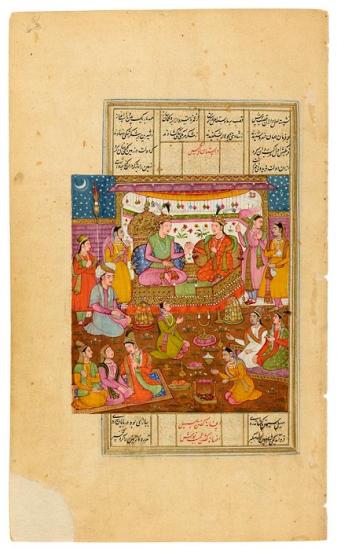
Shīrīn Entertains Khusrau in a Walled Garden
Khamsa (Quintet), in Persian, written by Mullā Fatḥ Muḥammad.
Purchased by Pierpont Morgan, 1910
Khusrau and Shīrīn went to Armenia, and visited her aunt, Queen Mihin Banu, who prepared many festivities and celebrations worthy of the king. Here, in a walled garden, on a moonlit night with many candles, the couple is seated on a low platform. Shīrīn offers Khusrau a cup of wine. The, queen, however, only permitted them to sit side by side in public after Shīrīn promised her that she would not be his before they were married. Nor did the queen permit them to be alone.
This episode appears in Khusrau va Shīrīn (1180), the second story in Niẓāmī's Khamsa (Quintet), a long poem that addresses religious and ethical topics.
Persian poetry
The Persians loved their poetry and their poets, though the Qur˒an warned against believing their words (sura 69.41) and "those straying in evil who follow them" (sura 26.224). While Arabic was the first language of Islam and the language of the Qur˒an, Persian was favored by poets. Even Firdausī's (940–1020) celebrated Shāhnāma (Book of Kings), the national epic of Persian, was written in verse—some 50,000 couplets! Rūmī (1207–1273), the best known of the Sufi poets, put poetry in perspective when he wrote, "A hundred thousand books of poetry existed / Before the word of the illiterate [Prophet] they were put to shame!" (Masnavī I, 529). Presented here are illustrations of Firdausī's Shāhnāma as well as works by Sa˓ dī (ca.1184–1292), Hāfiz (ca. 1320–1389), and Jāmī (1414–1492), regarded as the last of the great Sufi poets. Also featured are illustrations from each of the five poems of the Khamsa (Quintet), by Niẓāmī (ca. 1141–1209), especially Lailā and Majnūn (The Persian Romeo and Juliet) and Bahrām Gūr's Seven Princesses.
